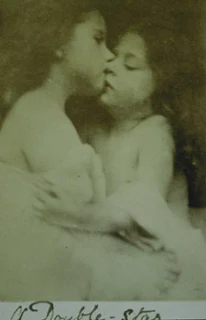Julia Margaret Cameron: Victorian Pioneer: 1815-1879
Julia Margaret Cameron by her son Henry Herschel Hay Cameron, 1870
‘Yes, the history of the human face is a book we don’t tire of, if we can get its grand truths, & learn them by heart. The life has so much to do with the individual character of each face influencing form as well as expression so much. It is so refreshing to meet one who has not had enthusiasm trodden out but in whose soul love, reverence, and trust survive the dust of this 19th Century life of hurry, worry, crush and crowd.’ (Unpublished letter from Cameron to Samuel G. Ward, June 16, 1869, Houghton Library, Harvard University)
Adeline’s father and Julia Margaret’s grandfather, the Chevalier Antoine de l’Etang, came from a long established noble family. At age thirteen he had been made a page to the young Marie Antoinette at the court of Versailles and later a member of King Louis XVI’s Carde du Corps. He was suddenly exiled from Versailles to serve in a cavalry regiment in Pondicherry some time in the 1780s. In 1788 the Chevalier married Therese Joseph Blin de Grincourt and Therese became Julia Margaret’s grandmother. The Chevalier spent his long career in India in the service of the British East India Company. There in Calcutta they raised three daughters who all went on to marry Englishmen. Within two generations the family was “English”, more importantly, part of an elite class of British civil servants who lived like aristocrats in a colonized land. Julia Margaret seems to have always considered herself English, but she probably did not set foot in England until she was a young woman. She grew up speaking English, French, and Hindi, which was used to talk to servants even in the Bengali region of India. She later learned German well enough to publish translations from that language.
Between 1812 and 1829, Julia Margaret’s mother Adeline bore ten children of whom seven girls survived to adulthood. Having a large family coincided with Adeline Pattle’s trips to and from Europe to visit her husband who was always travelling when work took him away.
The Pattle girls had an unconventional upbringing, even by colonial standards. It was the custom of British families in India to send their children back to the mother country for their early life and education. The climate of India was thought to be unhealthy for small children, and it was considered a parent’s clear duty to send them away. So it was not surprising when the time came for the Pattles to send their daughters abroad for their educations to France instead of England. So off they went to their grandmother’s home located at 1 Place St. Louis in Versailles between the ages of three and six. There they were educated to be a young lady by their grandmother, Therese de l’Etang whose husband the Chevalier was away in India until his death in 1840. The Pattle children became accustomed to their mother, Adeline Pattle ferrying her daughters back and forth between their two homes in Paris, Versailles, and Calcutta during the 1810s and 1820s. The fact that these separations were standard colonial practice did not make them any easier to withstand. Later, when Julia Margaret became Julia Margaret Cameron, a colonial matron herself, she too sent her children to England for their health and education.
Photographs are famously useful for transcending distances between people and alleviating the strains of separation. Photographs make the absent present, and that may have held a powerful psychic appeal for Julia Margaret. She first took up photography as her children left home, and she eventually left England, and her photographic career, to be reunited with her family in Ceylon. She gave important photographic albums of her work and other family portraits to her sisters Maria and Virginia. Julia Margaret’s life was defined by great distances and separations from loved ones. Her upbringing in France may have brought her close to her grandmother and sisters, but it created a distance from her father and mother, her aunts and her uncles. That distance mattered: Julia Margaret was arguably never as close to anyone as she was to the sisters with whom she spent most of her childhood. And she spent the rest of her life trying to manage the separations that inevitably occurred between herself and her husband, her sisters, her closest friends, and her children.
For instance, Cameron’s later photographs of children also emphasize an infantile unity between pairs. In photographs like The Double Star, Cameron places two children in very close proximity and fills the large glass plate with their almost interlocking heads.
Emily Tennyson said of her dear friend Julia Margaret Cameron, ‘We are not likely to find one to take her place so loving and strong in her woman’s way and so child-like in her faith’.
SOURCE From Life Julia Margaret Cameron and Victorian Photography by Victoria C. Olsen, 2003, Palgrave Macmillan Publishing
Please feel free to leave any questions or comments,




Comments
I'm glad you enjoyed reading my article!